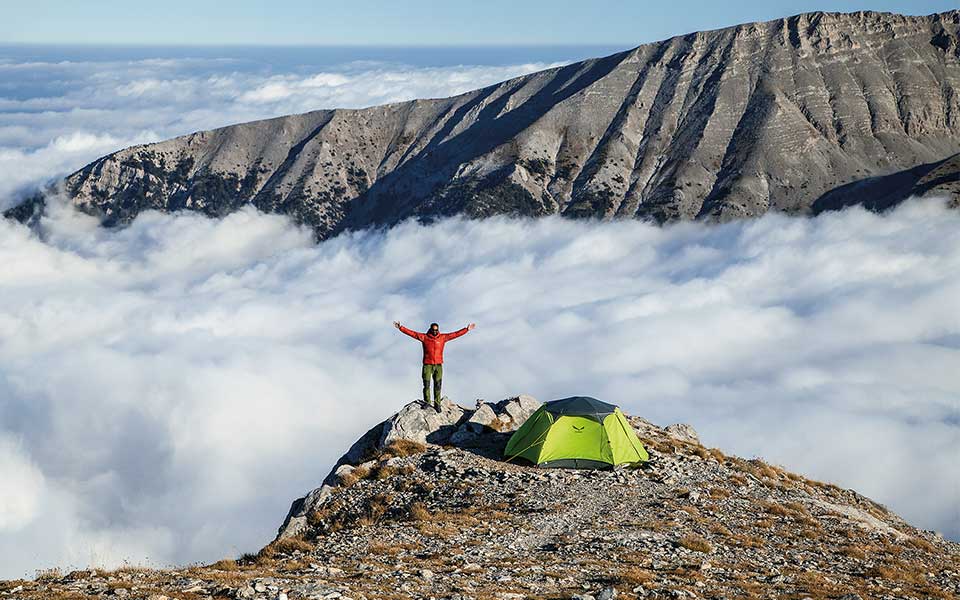Greece, celebrated for its azure seas and sun-drenched islands, also boasts a wealth of majestic mountains. In fact, about 80 percent of Greece’s landscape is characterized by mountains or semi-mountainous terrain, making it one of the most mountainous countries in Europe.
From the mythical heights of Mount Olympus, home of the ancient Greek gods, to the rugged peaks of the Pindus range, each mountain holds its own tale of natural beauty and cultural significance. The primary mountainous spine of Greece is the Pindus mountain range, serving as the mainland’s “backbone” and, in conjunction with the Rhodope Mountains in the northeast, form a symbolic “Γ” across the country’s landscape.
These majestic mountains not only offer unparalleled natural beauty but also serve as prime destinations for outward bound and mountain tourism. Whether you’re seeking exhilarating hiking trails, panoramic vistas, or cultural immersion amidst quaint alpine villages, Greece’s highest peaks promise unforgettable experiences for adventurers of all kinds.
Join us as we embark on a journey to the realm of the ancient gods, to discover the untamed beauty and timeless allure of ten of Greece’s highest mountains.
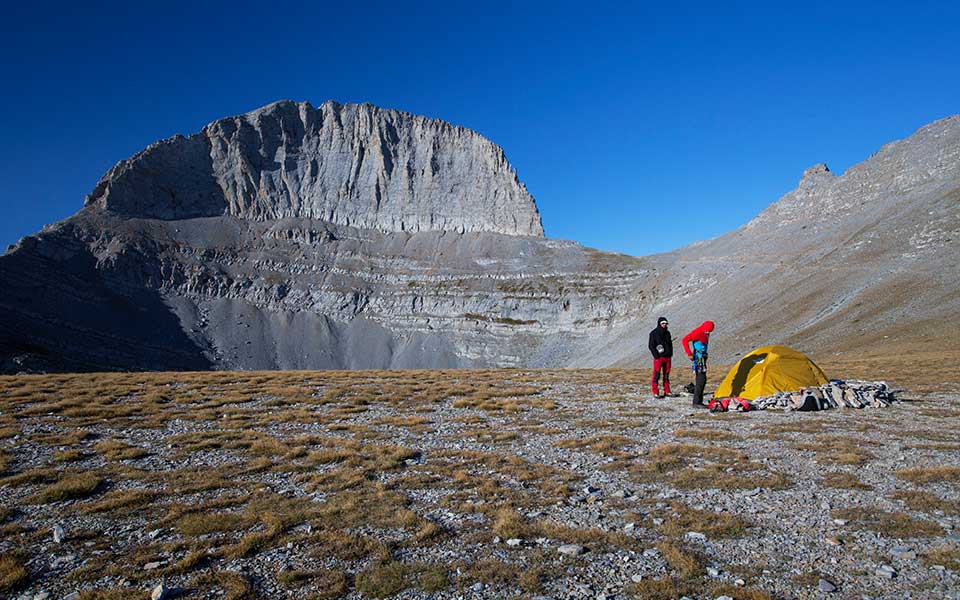
© Olga Charami
Olympus (2,917m)
Mount Olympus, standing tall at 2,917m, reigns supreme as the highest peak in Greece and carries profound significance in Greek mythology as the dwelling place of the Olympian gods. Nestled within the Olympus Range in northern Greece, on the border between Thessaly (Larissa) and Macedonia (Pieria), this majestic mountain boasts rugged cliffs, deep gorges, and lush forests, creating a breathtakingly diverse landscape. The summit known as Mytikas, meaning “nose,” towers at an elevation of 2,917.727m, making it one of Europe’s highest peaks.
Mount Olympus’ prominence in ancient Greek culture is evident through numerous references in literature and art, depicting it as the seat of Zeus and the site of divine gatherings. The mountain and its environs became Greece’s first National Woodland Park, inaugurated in 1938.
Today, Mount Olympus remains a hugely popular destination for mountaineers and hikers from all around the world, offering a variety of trails that wind through its verdant slopes and lead to its rocky summit. It continues to inspire awe and reverence, embodying the enduring spirit of Greek heritage and natural beauty.
For our guide on where to stay and visit on Mount Olympus, click here.
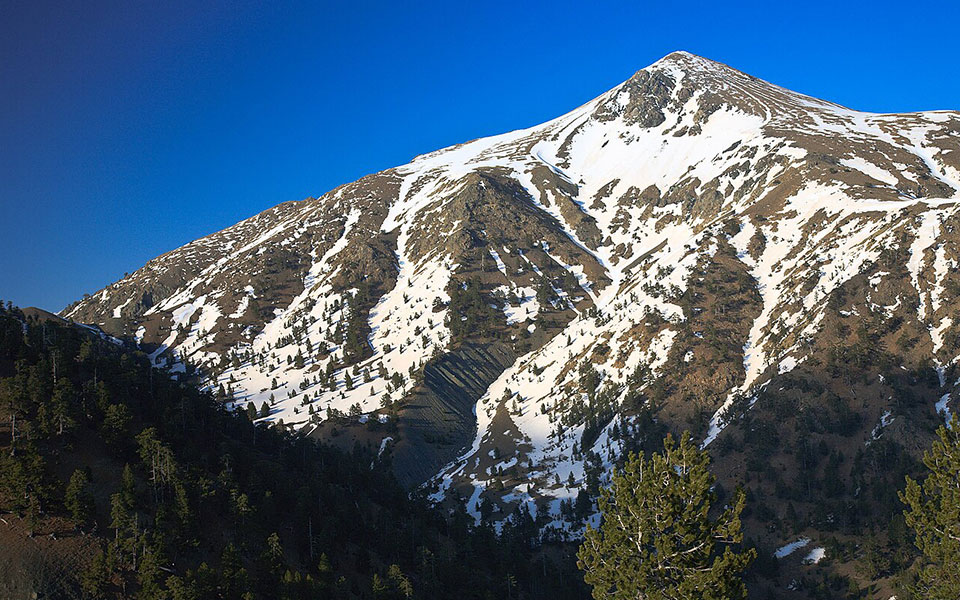
© Deyan Vasilev / Public domain
Smolikas (2,637m)
Mount Smolikas, the second-highest peak in Greece at 2,637m, stands proudly in the Pindus mountain range, located in Epirus, in the northwest of the country. Its rugged terrain is characterized by steep cliffs, alpine meadows, and dense forests, creating a haven for diverse flora and fauna. Smolikas holds historical significance as well, serving as a natural border during various periods of Greek history, separating the Ioannina region in the west from the Thessaloniki region to the east.
Mount Smolikas gives rise to the tributaries of the Aliakmonas, Venetikos, and Greveniotikos rivers. Its slopes are adorned with numerous mountain villages, including the renowned Samarina and Smixi. Among its notable features is the stunning Drakolimni lake (“Dragon Lake”), associated with tales of mythical creatures, and drawing the attention of countless hikers.
Today, Mount Smolikas attracts outdoor enthusiasts and adventurers seeking to explore its challenging hiking trails, picturesque vistas, and pristine wilderness. Its remote location and untouched beauty make it a treasure waiting to be discovered.
For more information on Mount Smolikas, click here.
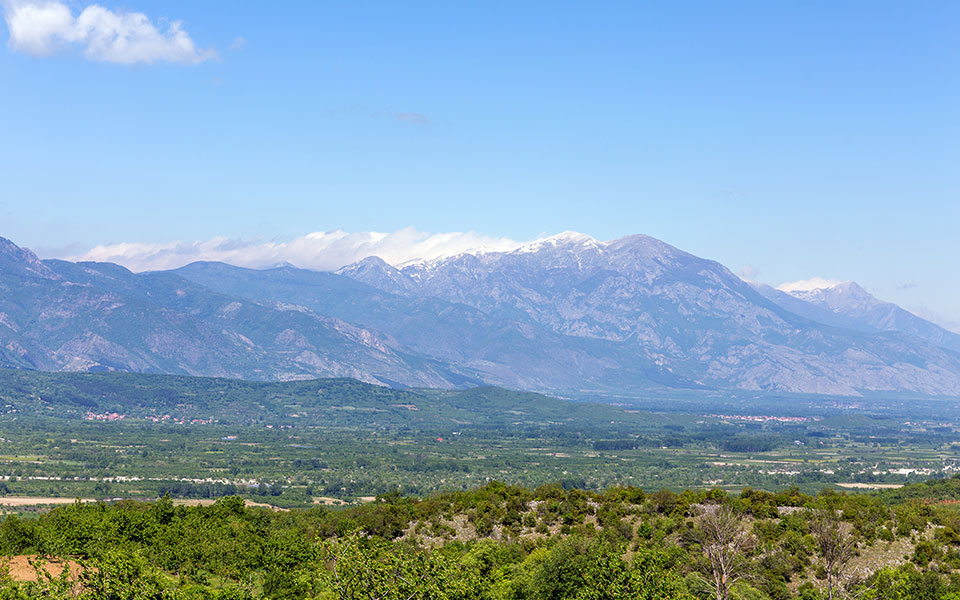
© Shutterstock
Voras (Kaimakstalan) (2,524m)
Greece’s third highest peak, Mount Voras, also known as Kaimaktsalan (from the Turkish word “kaymak,” meaning clotted cream), straddles the border between Greece and North Macedonia, reaching a height of 2,521 meters. Its rugged terrain is characterized by rocky slopes, alpine meadows, and dense forests, offering breathtaking views of the surrounding landscape. The mountain holds historical significance as a natural boundary between the two countries and has witnessed various cultural exchanges throughout history. In 1916, during World War I, it was the site of a long and bloody battle between Serbian and Bulgarian forces.
Mount Voras and its surrounding environment is noted for its subarctic climate, boasting short, cool summers and long, cold winters. Additionally, it serves as a popular destination for outdoor enthusiasts, offering opportunities for hiking, skiing, and other recreational activities.
One of its notable features is the Voras Ski Center, attracting visitors during the winter months.
For more information on the ski center and its environs, click here.
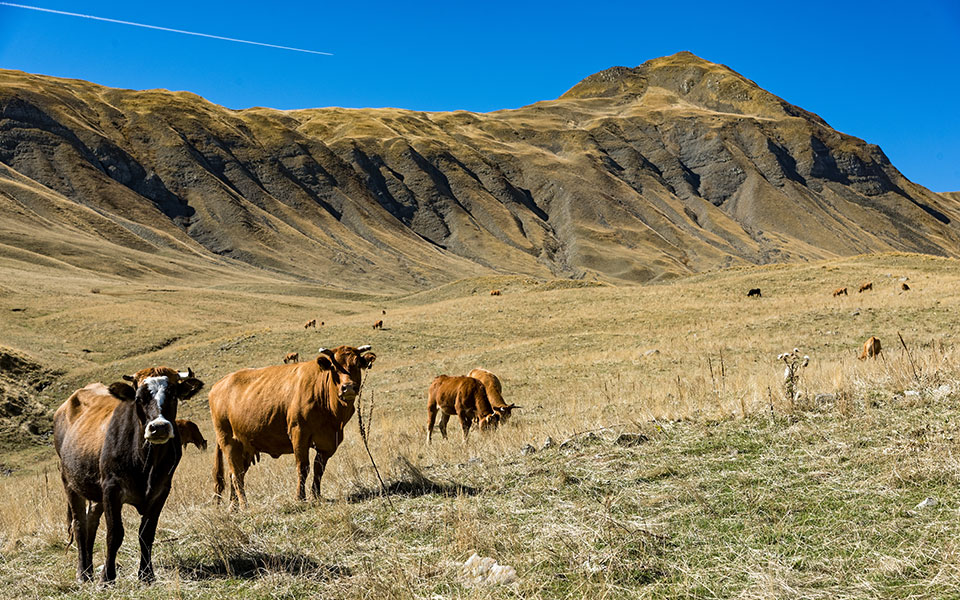
© Shutterstock
Grammos (2,520m)
Mount Grammos, standing at 2,520m, forms part of the northern Pindus Mountain range. Located on the Greek-Albanian border, in the northeastern part of the prefecture of Ioannina, the mountain is characterized by rugged peaks, glacial valleys, and lush beech and conifer forests, and is a popular destination for hikers and outdoor enthusiasts. Numerous water streams originate from Mount Grammos, with the most notable being the source of the Aliakmonas River, Greece’s longest river.
Throughout history, Mount Grammos has served as a natural barrier and has witnessed significant events, including battles during World War II and the Greek Civil War (most notably Operation Pyrsos in 1949). Its strategic location has shaped the region’s history and cultural identity.
Today, Mount Grammos remains a symbol of resilience and natural beauty, attracting hikers, climbers, and nature lovers from around the world. Its tranquil landscapes and rich history make it a captivating destination for those seeking adventure.
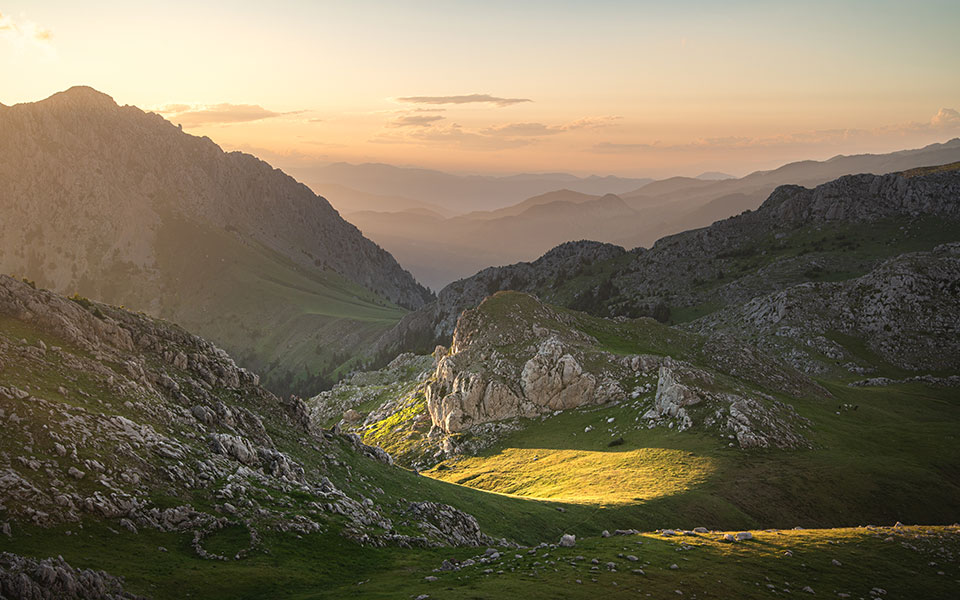
© Shutterstock
Giona (2,510m)
Mount Giona, standing majestically at 2,510m in Phocis, Central Greece, is renowned for its breathtaking geographical features – Greece’s second highest peak south of Mount Olympus. Located between the mountains of Parnassos to the east, Vardousia to the west, and Oeta to the north, its rugged terrain encompasses rocky peaks, deep gorges, and verdant forests, creating a diverse landscape that is home to as many as 60 species of endemic Greek flora, including wild horses, bears, wolves, griffon vultures and golden eagles. Boasting some of the steepest and most dramatic slopes in the Balkans, its highest peak is known as the “Pyramida.”
Known in classical antiquity as the “Aselinon Oros” (the “Moonless Mountain”), in Greek mythology, Selene, the goddess of the moon, was said to frequent Mount Giona to rendezvous with her beloved shepherd, Endymion. Legend has it that whenever she visited him, the moon would vanish from the night sky, leaving it bereft of its luminous glow.
Today, Mount Giona continues to be a popular year-round destination for hikers, climbers, and nature enthusiasts, offering a network of trails that wind through its pristine wilderness (the only blight on the landscape are the deep scars left behind by the old bauxite aluminum ore mines).
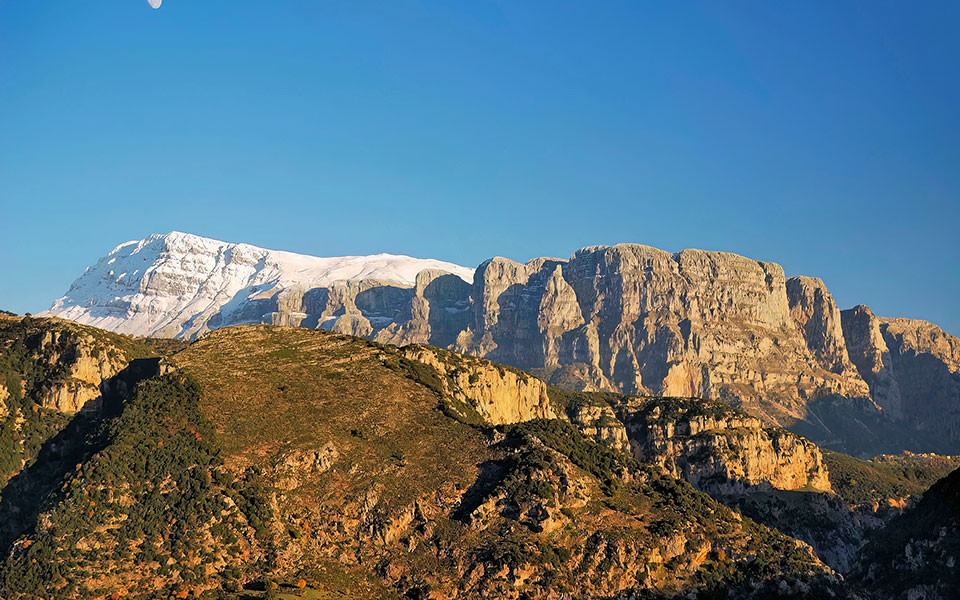
© Shutterstock
Tymfi (Gamila) (2,497m)
Returning to northwestern Greece, and the northern Pindus mountain range, Mount Tymfi, also known as Tymphe or Timfi, is a rugged and picturesque peak rising to 2,497m. Its distinct geographical features include the breathtaking 32-km-long Vikos Gorge – listed in the Guinness Book of Records as the world’s “deepest relative to its width” gorge – and the stunning alpine lake Drakolimni, known for its crystal-clear waters.
Rich in history and cultural significance, Mount Tymfi has been a source of inspiration for local legends and folklore. It is said to be the dwelling place of mythical creatures such as dragons and fairies, adding to its mystical allure. The mountain is also home to several extremely deep vertical cave systems, including the “Hole of Odysseus” and the “Chasm of Epos.”
Traditionally, Mount Tymfi has been inhabited by shepherds and farmers, who have shaped the landscape with their pastoral activities. Today, it remains a popular destination for outdoor enthusiasts, which, together with Vikos Gorge, forms part of the Vikos–Aoös National Park. The park attracts over 100,000 visitors each year, offering challenging hiking trails, rock climbing, and pristine wilderness.
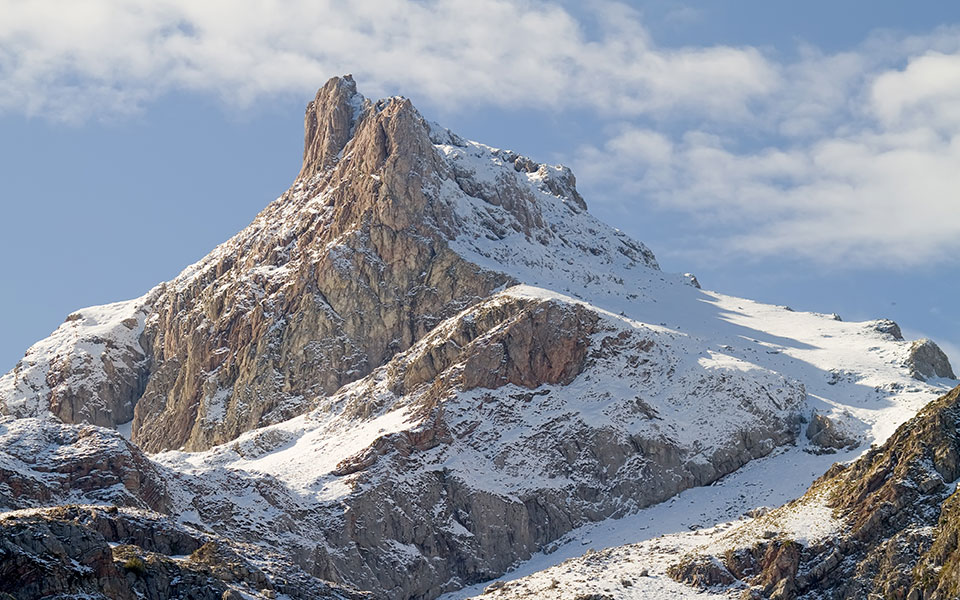
© Shutterstock
Vardousia (Korakas) (2,495m)
At the southernmost end of the Pindus mountain range sits the majestic Mount Vardousia, in Phocis, the heart of Greece. Characterized by rugged peaks, deep valleys, and dense forests, its highest peak, “Korakas,” rises to an elevation of 2,495m, making it the second tallest summit in central Greece after Mount Giona.
Mount Vardousia is segmented into three distinct sections: Northern Vardousia, featuring its peak Sinani soaring to 2,059m, the precipitous Western Vardousia, crowned by its highest point Soufles standing at 2,300m, and Southern Vardousia, home to the towering peak Korakas. Spanning approximately 25km from north to south, the entirety of the range boasts a diverse array of landscapes and is drained by tributaries of the Spercheios River to the north, the Mornos to the east and south, and the Evinos to the west.
Today, Mount Vardousia attracts outdoor enthusiasts year-round, seeking to explore its challenging hiking trails, cycling routes, picturesque villages (including Dafnos, Diakopi, Kallio and Koniakos), and rich biodiversity. Its pristine wilderness and cultural heritage make it a captivating destination in the heart of Greece.
Click our guide on a bike tour around Pindus, click here.
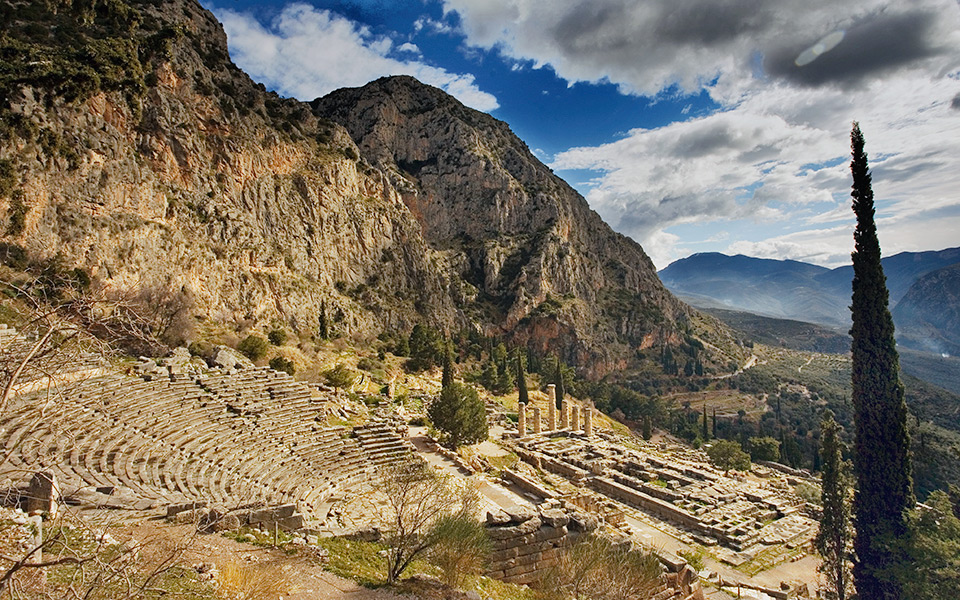
© Perikles Merakos
Parnassos (2,457m)
Mount Parnassos, rising to an elevation of 2,457m, towers above the central regions of Viotia (Boeotia), Phocis, and Phthiotida. Its rugged terrain encompasses deep gorges, rocky cliffs, and verdant slopes, making it a haven for outdoor enthusiasts.
In Greek mythology, Mount Parnassos is revered as the sacred home of Apollo and the Muses, serving as the mythical birthplace of poetry, music, and inspiration. The ancient sanctuary of Delphi, nestled on its southwestern slope, was once considered the center (“Omphalos” or navel) of the world and a site of pilgrimage for ancient Greeks seeking wisdom and guidance from the famous Oracle. The site was added to UNESCO’s list of World Heritage Sites in 1987.
The mountain is also dotted with numerous caves, some of which have historical and mythological significance. The Corycian Cave, for example, is said to have been the home of the Corycian nymphs in Greek mythology.
Today, Mount Parnassos is home to several notable settlements, each offering its own charm and attractions. Arachova, a picturesque town situated on its southern slopes, is renowned for its traditional architecture, lively atmosphere, and vibrant nightlife. Nearby is the famous Parnassos Ski Center, one of Greece’s most popular destinations for winter sports enthusiasts.
For more on walking trails in Parnassos National Park, click here.
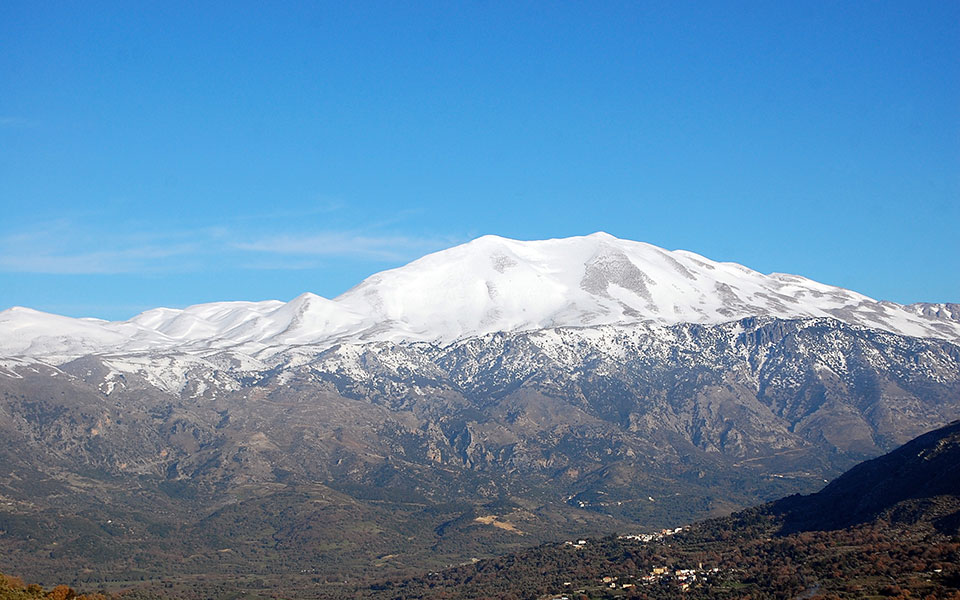
© Shutterstock
Ida (Psiloritis) (2,456m)
Mount Ida, also known as Psiloritis, reigns as the highest peak on the island of Crete, soaring to 2,456m above sea level. Located in the Rethymno regional unit, its rugged landscape is characterized by rocky cliffs, deep gorges, and lush vegetation, creating a haven for biodiversity.
In Greek mythology, Mount Ida holds significant importance as the birthplace of Zeus, the king of the gods. It is said that the “Ideon Andron,” the Idaean cave, located on the mountain’s slopes, was the legendary birthplace of Zeus, where he was raised by the nymphs.
Throughout history, Mount Ida has been a focal point of Cretan culture and tradition. It has served as a sacred site for worship and pilgrimage, with ancient sanctuaries and religious rituals dedicated to the mountain’s divine associations. Situated at an elevation of 1,187 meters, the archaeological site of Zominthos unveils a complex from the Minoan Bronze Age.
Today, Mount Ida, which forms part of a natural park, a member of UNESCO’s Global Geoparks Network, attracts hikers, mountaineers, and nature lovers from around the world, seeking to explore its scenic trails and discover its rich history.
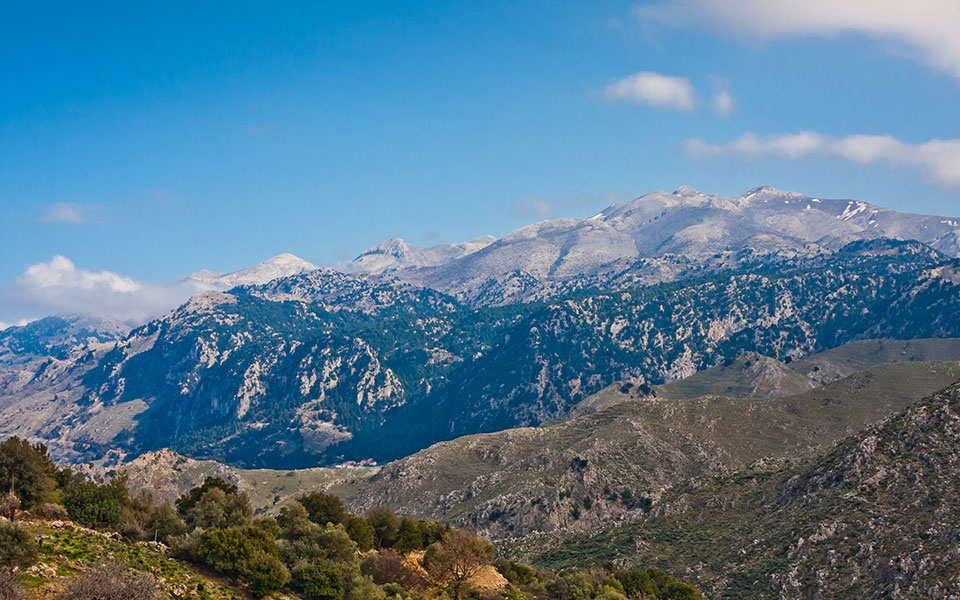
© Shutterstock
White Mountains (Lefka Ori) (2,454m)
The White Mountains, known as Lefka Ori in Greek (“Madares” in the Cretan dialect), stand as a majestic mountain range dominating the Hania prefecture of western Crete. With peaks reaching heights of over 2,400m, their snow-capped summits – over 30 above 2,000m – contrast beautifully with the azure Mediterranean skies and rugged terrain below. Deep gorges, such as the famous Samaria Gorge, one of Europe’s longest, carve through the landscape, offering stunning vistas and challenging hiking trails.
Steeped in history and mythology, the White Mountains have been a source of inspiration for countless generations. Throughout history, the mountains have served as a natural fortress, providing refuge for Cretans during times of invasion and conflict, and a hiding place for resistance fighters. Uniquely in the northern hemisphere, the central and southern parts of the White Mountains resemble a lunar landscape, technically called a “high desert.”
Today, the White Mountains continue to captivate visitors with their breathtaking beauty, rich biodiversity, and storied past, making them a must-visit destination for nature lovers and adventurers alike.
For more on the Lefka Ori mountain range, click here.

